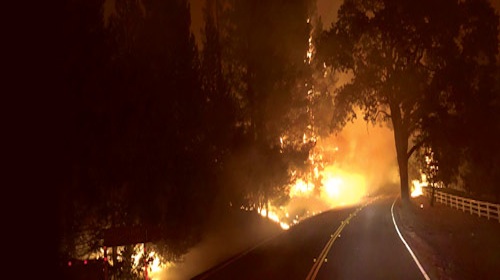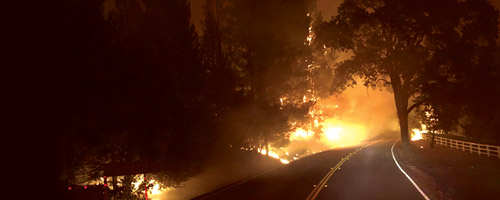9:30 p.m.
On October 8, Loren Davis, fire chief at Mountain Volunteer Fire Department in Sonoma County, was sitting at a poker table at Graton Casino in Rohnert Park at around 9:30 p.m. when his pager went off. He had gotten off duty from his shift as a firefighter at Eldridge Fire Department in Sonoma County at 7 a.m. that morning, and was looking forward to a relaxing evening.
He glanced at his pager. The message read: “Structure fire at Mountain Ranch Road.” He immediately left the card game, jumped into his work truck and started up the freeway toward the station on Sharp Road between the Sonoma and Napa County line. “The winds were howling,” he recalls. It was a 20-mile-drive and as he approached, he saw a red glow in the distance.
Meanwhile, Don Fowler, assistant fire chief at Mountain Volunteer Fire Department, was asleep at his home near Mountain Ranch Road in Calistoga when he received two calls. “My pager went off first. It read, ‘Smoke investigation.’ Then I received a text that said, ‘Structure fire on Mountain Ranch Road.’ It was UTL [unable to locate.]” Fowler sprung out of bed and met with an engineer for the type one engine, Tony Riedell. He informed Fowler he made the trip to Mountain Ranch Road, to find that the fire was UTL. “Usually we go home,” says Fowler. “But I kept going.” As Reidell proceeded to Franz Valley School Road, helping to locate the wildfire, Fowler continued on to Mountain Ranch Road where he met with his neighbors, owners of Mayacamas Ranch. “As we looked out, we could smell it, but couldn’t see it,” he recalls.
At 10:20 p.m. in Forestville, Clint St. Martin, a volunteer firefighter, was cooking a late dinner with his girlfriend at her house after a long day of rebranding a Redwood Credit Union office. He received a call from a junior firefighter at the Mountain Volunteer Fire Department, responding to a smoke and fire investigation. They needed an engineer, and asked St. Martin to report to the station. In that moment, he thought it was unusual to receive a call from the firehouse this late in the evening and the firefighter on the other end of the line sounded anxious. He was often called in to help with smoke investigations, but usually the call was cancelled before he arrived. This time felt different.
He jumped on his motorcycle and headed to the firehouse. The 25-minute-drive was along a winding road. It was windy and unusually warm. When he left Forestville, it was around 60 degrees, but as he ascended Mark West Springs Road, the temperature was rising into the 70s and 80s, and the winds were picking up. “I got hit in the helmet by a dead branch the size of an arm that broke off a tree,” St. Martin recalls. He knew something wasn’t right. “I thought I was going to get blown off the road.”
10:45 p.m.
St. Martin arrived at the station on Sharp Road near Calistoga at about 10:45 p.m. and heard the dispatch mention a fire on Franz Valley School Road. He quickly pulled on his fire gear, and the three men drove down in their Type 3 wildland fire engine. The view in the valley below looked exceptionally menacing, with the glow slowly evolving to a much larger red mass. Five minutes later, they would find themselves in the center of a firestorm. “Nothing about this was common,” says Davis. “We could see the fire was ripping. We drove in—about a mile and around the corner was a solid wall of fire.”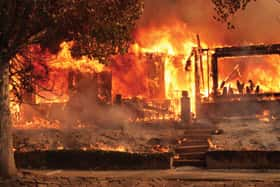
At 11:08 p.m., the fire was sheeting across the road, like a river of flames, and crowning over the trees. “The fire at the ground level was being sucked back into the fire,” Davis explains. With a crown fire above the trees, prevailing winds of up to 70 miles per hour and low humidity in the single digits, the fire was relentless. “You can’t stop a fire like this,” he says. “All you can do is get ahead of it, warn people to get out and wait for the winds to die down.”
12:30 a.m.
Fowler recalls the moment his chief, Davis, got the call to evacuate the area. “He asked if my family evacuated,” he says. They hadn’t, and Fowler’s aunt was in her ranch home located on Mountain Ranch Road. “Go get them out!” Davis ordered. Fowler fled to his family’s home, where the fire was surrounding. “I tried to stop the fire and get ahead of it at my aunt’s place. I used my skid steer to cut fire lines in the dirt.”
Davis and St. Martin knew there was no other choice than to evacuate the area. Davis recalls the fire moving faster than they could drive. According to both men, the evacuations were similar to orchestrating an Army tactic. They quickly formed an impromptu task force. “The fire had wrapped around us from Franz Valley Road to Mark West,” says St. Martin.
Davis and St. Martin connected with Paul Fleckenstein, battalion chief at CAL FIRE and Steve Baxman, fire chief at Monte Rio. There was no time to debate possibilities, and they agreed to get ahead of the fire and evacuate as many residents as possible. They made their way through the neighborhoods, announcing on the PA: “The canyon is on fire. Evacuate your homes.”
Next, they approached each house individually, along with additional fire engines conducting similar evacuations. “Clint [St. Martin] and I went door to door,” recalls Davis. The fire continued to progress.
“Power lines were down and the dirt was so dry, the root structure had nothing to hang on to,” says St. Martin. “Trees came down like toothpicks
At midnight, they received a radio call for a rescue on Franz Valley Road, near Safari West. “Somebody was trapped and couldn’t get out,” says Davis. As they approached the road, they were cut off by a solid wall of flames and couldn’t get through. There was no other option but to turn around. “It would be suicide to go through that.”
By 12:30 a.m., Davis and St. Martin headed back to Porter Creek Road, toward Mark West Springs Road. “We had entered the most horrific fire of my life,” says Davis. On the way, they drove past St. Martin’s neighborhood. His tenant was asleep in her studio apartment, not responding to the PA announcement and the fire was quickly approaching. “She didn’t respond to the siren, my horn or my PA announcement,” he recalls. “Embers and smoke were coming over the top of her studio.” At this point, he knew her vehicle was unable to withstand the conditions. St. Martin pounded on the door. She opened it wearing her pajamas and gasping for air. He sent her off in his Ford F-150, as her studio filled with smoke.
In the early morning of October 9, Davis and St. Martin evacuated nearly 30 residents from their homes. The two-man crew, along with sheriff deputies and another local fire engine, moved them to safety in the Mark West Lodge parking lot, away from flames. “We protected about 30 people,” says Davis. “We gave a sense of protection to the people. It was the best we could do.”
Amongst the evacuees was Joe Grey, a former Marine who deployed to Iraq in 2008 with St. Martin. The two hadn’t seen each other since their tour in Iraq, and suddenly it was as if they were in the Marine Corps once again. “We leaned against his pickup truck. Joe popped a dip in his mouth and handed me some beef jerky,” St. Martin recalls with a laugh. Grey was insistent on helping with evacuations. “As a former Marine who deployed with Clint, he had the training and helped us knock on doors,” says Davis. Limited on his access to help, St. Martin recalls Grey banging his head on a wall, frustrated he couldn’t fully assist in the fire truck or on the fire line for the next several days.
6 a.m.
By 6 a.m. Monday morning, the air was scorched and a veil of smoke still lingered heavily. “One side of the sky was dark, smoky and eerie,” St. Martin recalls. “The other side was bright, blue and almost cheery. It was like waking up from a nightmare to a clear, new day.” Davis recalls finally driving up Mark West Springs Road and Porter Creek Road at sunrise after the sheriff’s department was able to evacuate civilians. “It was smoky, and I saw a lot of burnt down houses,” he says. With the light of day barely there, St. Martin, Davis and the CAL FIRE team, who had been up already fighting a fire in southern California for more than 36 hours, continued to pursue the fire into the woods and protect the remaining structures. More than 2,500 feet of hose was burnt, sitting on hot ash and intercepted by rogue flames. CAL FIRE desperately needed a new hose, as water was surging from the incinerated water source. The danger of having a firefighter more than 1,000 feet out and have his hose destroyed can be deadly. “I had about 1,000 linear feet to give them,” said St. Martin. CAL FIRE needed water, and St. Martin and Davis returned to the station where they retrieved their 1979 water tender truck, returning with 2,500 gallons of water for CAL FIRE. They continuously refilled each other’s water source, pumping from local wells.
At 10 a.m., Davis was operating the water tender through the morning, and St. Martin jumped at the opportunity to catch a ride with CAL FIRE back to Calistoga where he met with his uncle, Mark Young, owner of Brannan’s restaurant in Calistoga. St. Martin had been running on adrenaline non-stop for 36 hours and needed to rest and refuel. His uncle’s business partner, Ron Goldin, took one look at St. Martin and said, “Don’t forget to eat.” Goldin made him a breakfast burrito.
3 p.m.
After two to three hours of sleep at his uncle’s home, St. Martin awoke around 3 p.m. “I needed to get back to the firehouse, but it was blocked off,” he recalls. “I had my helmet on and my wildland gear, which was enough credentials to get through.”
On the way, he drove to his home on Mark West Springs Road. At 3:30 p.m., St. Martin found his house burned to the ground. “It was completely annihilated,” he says. Devastated, he dropped to his knees and cried when he saw the remains of the home he spent seven years building. “I could feel hot tears on my face and my stomach ached.”
Nevertheless, there was no time to mourn the loss. St. Martin checked on remaining neighbors and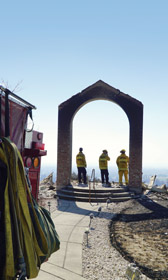 homes he knew in the area before returning to the firehouse at around 5 p.m. The team regrouped, restocked equipment and water, continued to put out small fires and heat spots as the danger was far from over.
homes he knew in the area before returning to the firehouse at around 5 p.m. The team regrouped, restocked equipment and water, continued to put out small fires and heat spots as the danger was far from over.
“I’ve never been so sure I was going to die,” St. Martin says of taking on the blaze. “But, there’s nowhere I would’ve wanted to be than with those guys, fighting the fire. It was 100 percent our choice to be there as volunteer firefighters and I was on full adrenaline, level 10 until it was totally out.”
11 p.m.
Loren was needed at the Eldridge Fire Department, and he reported for duty at 11 p.m. in Glen Ellen. “I just kept working,” he says.
Fowler, who daringly took on the fires surrounding his family’s home, spent more than 11 hours between the four properties on Mountain Ranch Road, cutting fire lines, containing fires with dirt and releasing the chickens from their coops. With no access to water or electricity, “You can’t send somebody out,” he says. St. Martin attributes Fowler for playing a major role in saving the properties on Mountain Ranch Road and Triple S Ranch.
The next day
By the next evening, the smoke began to clear, and the first responders from Mountain Volunteer Fire Department continued to contain what would be the deadliest and most destructive wildfire in California history.
Davis and his volunteer crew weren’t the only ones on the scene during those fateful first 24 hours. They shared countless tasks and life-saving decisions with members of several other first response units. Though Davis’ home wasn’t affected in the fire, his advice to the residents of Sonoma and Napa counties is to make space. “In a normal wildland fire, defense space is golden,” he says. “If we come up and knock on your door to evacuate, do it. Don’t second guess it.”
After 15 years with the fire department, Fowler has seen his fair share of ruin and loss. “This was by far the worst I’ve ever seen, as far as devastation,” he says. “The amount of houses lost in the short length of time, it was so fast, people couldn’t get out.”
The devastation caused by the fires may forever impact our communities and everyone affected. If there’s anything good to come from a natural disaster, as Napa and Sonoma counties recover and rebuild, perhaps it is to learn from the experience and move forward as best as possible. For St. Martin, that means staying close to his community. “It’s our job as a community to look out for each other no matter what you do or who you are,” he says. “That is what community is about.”
First Responders
Members of Mountain Volunteer Fire Department
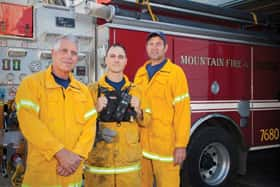 In Sonoma County, there are currently 10 volunteer fire departments that provide emergency fire, medical aid and rescue services to our local communities. Thirteen members make up the team at Mountain Volunteer Fire Department on Sharp Road in Sonoma County, where 10 of its volunteers were on scene during the Tubbs and Nuns fires.
In Sonoma County, there are currently 10 volunteer fire departments that provide emergency fire, medical aid and rescue services to our local communities. Thirteen members make up the team at Mountain Volunteer Fire Department on Sharp Road in Sonoma County, where 10 of its volunteers were on scene during the Tubbs and Nuns fires.
Following the Hanley/Nuns Canyon fires of 1964 that destroyed a large portion of land from Mt. St. Helena to Santa Rosa, The Mountain Volunteer Fire Department was established in 1968 as both a fire department and a social organization. Nearly 50 years later, the department receives approximately 100 calls annually and saves the county millions of dollars. 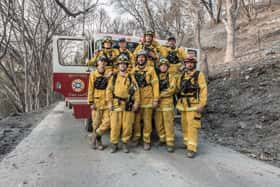
“We have estimated the volunteer departments saved the county more than $4 million per year, providing basically free services,” says Mountain Volunteer Fire Chief, Loren Davis. “But just because we don’t pay our volunteers, doesn’t mean it costs nothing.” Davis lists fuel, repairs, vehicle and responder insurance and utilities. “We also replace fire engines when they’re ‘too old and worn out,’” he adds. “It costs about $65,000 per year to run Mountain Volunteer Fire Department.” While the county provides funding, the department has to “flip pancakes,” cook dinner and hold various fundraisers to make ends meet, Davis says.
Davis and the rest of the crew are still trying to wrap their heads around the number of hours spent on the recent Tubbs and Nuns fires. “We had 10 volunteers from my department on both the Tubbs Fire and the Nuns Fire at various times over two weeks,” says Davis. He estimates 1,500 man hours shared amongst the volunteers at the Mountain Volunteer Fire Department within those two weeks. “All of the Sonoma County volunteer departments contributed manpower and materials to this incident.”


